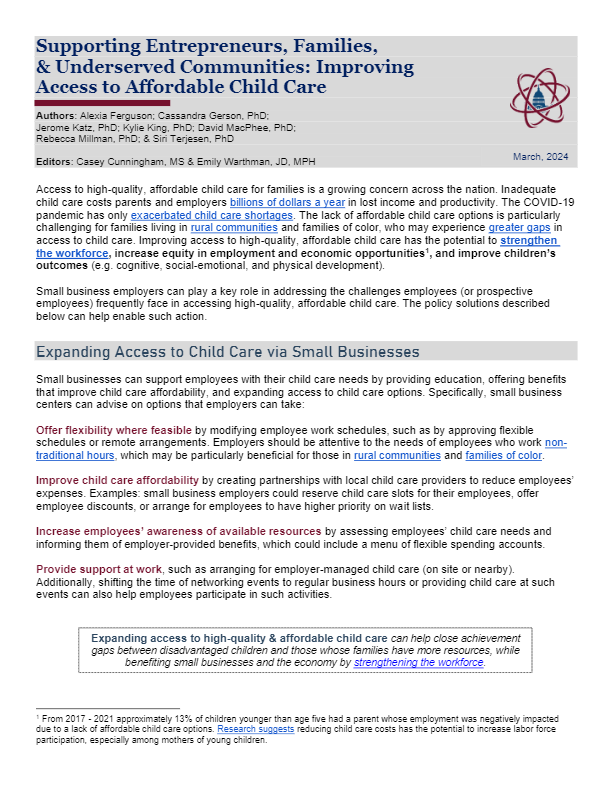
Access to high-quality, affordable child care for families is a growing concern across the nation. Inadequate child care costs parents and employers billions of dollars a year in lost income and productivity. The COVID-19 pandemic has only exacerbated child care shortages. The lack of affordable child care options is particularly challenging for families living in rural communities and families of color, who may experience greater gaps in access to child care. Improving access to high-quality, affordable child care has the potential to strengthen the workforce, increase equity in employment and economic opportunities*, and improve children’s outcomes (e.g. cognitive, social-emotional, and physical development).
Small business employers can play a key role in addressing the challenges employees (or prospective employees) frequently face in accessing high-quality, affordable child care. The policy solutions described below can help enable such action.
Expanding Access to Child Care via Small Businesses
Small businesses can support employees with their child care needs by providing education, offering benefits that improve child care affordability, and expanding access to child care options. Specifically, small business centers can advise on options that employers can take:
Offer flexibility where feasible by modifying employee work schedules, such as by approving flexible schedules or remote arrangements. Employers should be attentive to the needs of employees who work non-traditional hours, which may be particularly beneficial for those in rural communities and families of color.
Improve child care affordability by creating partnerships with local child care providers to reduce employees’ expenses. Examples: small business employers could reserve child care slots for their employees, offer employee discounts, or arrange for employees to have higher priority on wait lists.
Increase employees’ awareness of available resources by assessing employees’ child care needs and informing them of employer-provided benefits, which could include a menu of flexible spending accounts.
Provide support at work, such as arranging for employer-managed child care (on site or nearby). Additionally, shifting the time of networking events to regular business hours or providing child care at such events can also help employees participate in such activities.
Policy Recommendations to Support Small Businesses & Families
To address the complex issue of improving access to high-quality, affordable child care, policymakers can consider a multifaceted approach to maximize opportunities for impact. Promising strategies to reduce barriers to child care include:
- Incentivize small businesses to engage in strategies that improve employees’ access to child care. Large businesses typically have more resources to provide on-site child care. Small businesses can benefit from:
- Providing employee benefits at a lower cost through collaborations or by offering flex spending accounts.
- Assistance in identifying grants or small business loans (e.g., SBA loans) that support high-quality child care.
- Bolster the child care workforce, particularly in locations with the greatest need, including rural communities.
- New child care providers could be recruited into the field using intermediary organizations and may benefit from training to promote quality child care.
- Strengthen the infrastructure needed to care for toddlers and infants – an age group that requires more resources – so existing providers can increase the number of children served.
- Increase support for home-based child care providers through government-supported loans or grants, business or skills trainings, or raising families’ awareness of available resources.
- Increase financial support, such as grants and subsidies, to help more families cover the costs of child care. Preliminary research has shown that increasing reimbursement rates through state subsidy policies can positively impact program quality and participation by eligible families. Incentives can be offered to increase the number of child care providers open during non-standard working hours.
- Expand or create child care or early learning facilities in rural communities through partnerships with other private and public-sector stakeholders. Small business development centers can also provide advice and technical assistance to child care service provider entrepreneurs.
- Support additional research and improvements to data collection related to child care programs’ capacity and enrollments by age. Studying parents’ and caregivers’ decision-making process when selecting child care options can also help assess needs when considering supply and demand.
___________________
* From 2017 – 2021 approximately 13% of children younger than age five had a parent whose employment was negatively impacted due to a lack of affordable child care options. Research suggests reducing child care costs has the potential to increase labor force participation, especially among mothers of young children.
Select Resources
- Trivitt, et al. (2023). Child Care Policy Efficiency: What States Can Do to Promote Affordable, Accessible, High-Quality Child Care. Heartland Forward.
- Collier, M. (2021). Child Care Access for Families with Non-Standard Work Hours. Research-to-Policy Collaboration Fact Sheet.
- The National Association for Family Child Care (NAFCC). Family Child Care Research & Data. Fact Sheet.
- USDA Rural Development & HHS – ACF. (2021). Joint Resource Guide: To strengthen & expand child care facilities in rural communities.
- Adams, G. & Hernandez-Lepe, F. (2021). The Small Business Administration & Home-Based Child Care Providers. Urban Institute Brief.
- Stanczyk et al. (2019). Employers, Work-Family Supports, and Low-Wage Workers. Urban Institute Research Report.
- Bromer, et al. (2021). The Shifting Supply of Regulated Family Child Care in the U.S. Herr Research Center. Erikson Institute. Lit Review.
The Research-to-Policy Collaboration (RPC) works to bring together research professionals and public officials to support evidence-based policy. Please visit their website to learn more.
Key Information
RPC Website
Research-to-Policy Collaboration
Publication DateMarch 20, 2024
Topic Area(s)Social Services, Education and Child Development, Economy and Entrepreneurship
Resource TypeWritten Briefs
Share This Page
Access to high-quality, affordable child care for families is a growing concern across the nation. Inadequate child care costs parents and employers billions of dollars a year in lost income and productivity. The COVID-19 pandemic has only exacerbated child care shortages. The lack of affordable child care options is particularly challenging for families living in rural communities and families of color, who may experience greater gaps in access to child care. Improving access to high-quality, affordable child care has the potential to strengthen the workforce, increase equity in employment and economic opportunities*, and improve children’s outcomes (e.g. cognitive, social-emotional, and physical development).
Small business employers can play a key role in addressing the challenges employees (or prospective employees) frequently face in accessing high-quality, affordable child care. The policy solutions described below can help enable such action.
Expanding Access to Child Care via Small Businesses
Small businesses can support employees with their child care needs by providing education, offering benefits that improve child care affordability, and expanding access to child care options. Specifically, small business centers can advise on options that employers can take:
Offer flexibility where feasible by modifying employee work schedules, such as by approving flexible schedules or remote arrangements. Employers should be attentive to the needs of employees who work non-traditional hours, which may be particularly beneficial for those in rural communities and families of color.
Improve child care affordability by creating partnerships with local child care providers to reduce employees’ expenses. Examples: small business employers could reserve child care slots for their employees, offer employee discounts, or arrange for employees to have higher priority on wait lists.
Increase employees’ awareness of available resources by assessing employees’ child care needs and informing them of employer-provided benefits, which could include a menu of flexible spending accounts.
Provide support at work, such as arranging for employer-managed child care (on site or nearby). Additionally, shifting the time of networking events to regular business hours or providing child care at such events can also help employees participate in such activities.
Policy Recommendations to Support Small Businesses & Families
To address the complex issue of improving access to high-quality, affordable child care, policymakers can consider a multifaceted approach to maximize opportunities for impact. Promising strategies to reduce barriers to child care include:
- Incentivize small businesses to engage in strategies that improve employees’ access to child care. Large businesses typically have more resources to provide on-site child care. Small businesses can benefit from:
- Providing employee benefits at a lower cost through collaborations or by offering flex spending accounts.
- Assistance in identifying grants or small business loans (e.g., SBA loans) that support high-quality child care.
- Bolster the child care workforce, particularly in locations with the greatest need, including rural communities.
- New child care providers could be recruited into the field using intermediary organizations and may benefit from training to promote quality child care.
- Strengthen the infrastructure needed to care for toddlers and infants – an age group that requires more resources – so existing providers can increase the number of children served.
- Increase support for home-based child care providers through government-supported loans or grants, business or skills trainings, or raising families’ awareness of available resources.
- Increase financial support, such as grants and subsidies, to help more families cover the costs of child care. Preliminary research has shown that increasing reimbursement rates through state subsidy policies can positively impact program quality and participation by eligible families. Incentives can be offered to increase the number of child care providers open during non-standard working hours.
- Expand or create child care or early learning facilities in rural communities through partnerships with other private and public-sector stakeholders. Small business development centers can also provide advice and technical assistance to child care service provider entrepreneurs.
- Support additional research and improvements to data collection related to child care programs’ capacity and enrollments by age. Studying parents’ and caregivers’ decision-making process when selecting child care options can also help assess needs when considering supply and demand.
___________________
* From 2017 – 2021 approximately 13% of children younger than age five had a parent whose employment was negatively impacted due to a lack of affordable child care options. Research suggests reducing child care costs has the potential to increase labor force participation, especially among mothers of young children.
Select Resources
- Trivitt, et al. (2023). Child Care Policy Efficiency: What States Can Do to Promote Affordable, Accessible, High-Quality Child Care. Heartland Forward.
- Collier, M. (2021). Child Care Access for Families with Non-Standard Work Hours. Research-to-Policy Collaboration Fact Sheet.
- The National Association for Family Child Care (NAFCC). Family Child Care Research & Data. Fact Sheet.
- USDA Rural Development & HHS – ACF. (2021). Joint Resource Guide: To strengthen & expand child care facilities in rural communities.
- Adams, G. & Hernandez-Lepe, F. (2021). The Small Business Administration & Home-Based Child Care Providers. Urban Institute Brief.
- Stanczyk et al. (2019). Employers, Work-Family Supports, and Low-Wage Workers. Urban Institute Research Report.
- Bromer, et al. (2021). The Shifting Supply of Regulated Family Child Care in the U.S. Herr Research Center. Erikson Institute. Lit Review.
The Research-to-Policy Collaboration (RPC) works to bring together research professionals and public officials to support evidence-based policy. Please visit their website to learn more.

Key Information
RPC Website
Research-to-Policy Collaboration
Publication DateMarch 20, 2024
Topic Area(s)Social Services, Education and Child Development, Economy and Entrepreneurship
Resource TypeWritten Briefs
Share This Page
LET’S STAY IN TOUCH
Join the Evidence-to-Impact Mailing List
Keep up to date with the latest resources, events, and news from the EIC.




